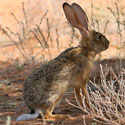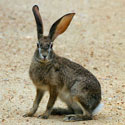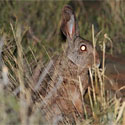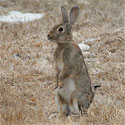|
Family: Leporidae (hares, rabbits)
Life
>
Eukaryotes >
Opisthokonta >
Metazoa (animals) > Bilateria > Deuterostomia >
Chordata > Craniata > Vertebrata (vertebrates) >
Gnathostomata (jawed vertebrates) > Teleostomi (teleost
fish) > Osteichthyes (bony fish) > Class:
Sarcopterygii (lobe-finned fish) > Stegocephalia
(terrestrial vertebrates) > Reptiliomorpha > Amniota >
Synapsida (mammal-like reptiles) > Therapsida > Theriodontia
> Cynodontia > Mammalia (mammals)
> Placentalia (placental mammals) >
Euarchontaglires > Glires > Lagomorpha (rabbits, hares and
pikas)
Species indigenous to southern Africa
|
Lepus capensis (Cape
hare) |
 |
|
Lepus saxatilis (Scrub hare) |
 |
|
Pronolagus rupestris (Smith's red rock rabbit) |
|
|
Pronolagus saundersia (Hewitt's
red rock rabbit) |
 |
|
Pronolagus crassicaudatus (Natal red rock rabbit)
|
|
|
Pronolagus randensis (Jameson's red rock rabbit) |
|
|
Bunolagus monticularis (Riverine
rabbit) The Riverine Rabbit is endemic to the central Karoo
Desert of theNorthern and Western Cape where it occupies a specialised
riverine habitat that has been considerably reduced and fragmented as a
result of agricultural practices. Hence the species is now considered
Critically Endangered and efforts are being made to conserve the wild
population. It is the only indigenous burrowing rabbit in Africa and
depends on the soft alluvial soils in the river floodplains to construct
stable breeding stops (burrows). It is solitary and nocturnal, feeding at
night and resting during the day in shallow depressions (forms) that are
scraped out under Karoo shrubs. One or two helpless young (“kittens”) are
born during August through May. They are blind, hairless and reared in a
lined burrow. Population growth is very slow as a female only produces an
average of 4 young in her lifetime of two to three years. |
|
Species naturalised in southern Africa
|
Oryctolagus cuniculus (European
rabbit)
Naturalised on guano islands off South Africa; also on
Robben Island. |
 |
|
